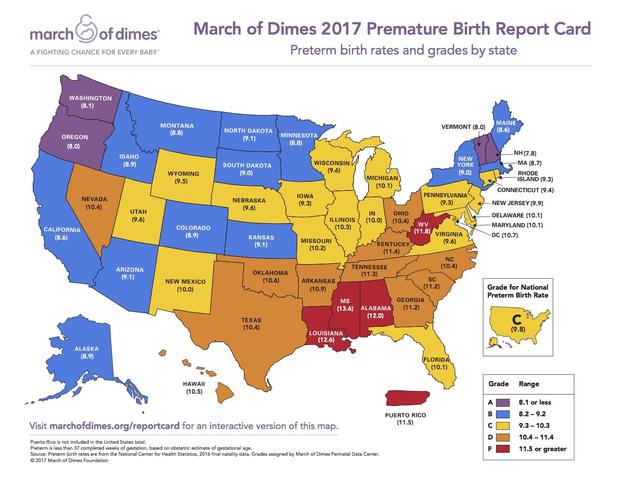U.S. preterm births rise for second year in a row
After nearly a decade of decline, the U.S. rate of preterm birth — the largest contributor to infant death in the country — increased again in 2016 for the second year in a row, according to a new report from the March of Dimes.
More than 380,000 babies are born prematurely each year, putting them at greater risk of death before their first birthday. They're also more likely to suffer lifelong disabilities and chronic health conditions including breathing problems, jaundice, vision loss, cerebral palsy and intellectual delays.
In addition to the health toll, the National Academy of Medicine reports that preterm birth accounts for more than $26 billion each year in avoidable medical and societal costs.
The "March of Dimes Premature Birth Report Card" cites data from the National Center for Health Statistics (NCHS) that found the U.S. preterm birth rate went up from 9.6 percent of births in 2015 to 9.8 percent in 2016.
Some communities were hit even harder than others.
"The 2017 March of Dimes Report Card demonstrates that moms and babies in this country face a higher risk of preterm birth based on race and zip code," Stacey D. Stewart, president of the March of Dimes, said in a statement. "We see that preterm birth rates worsened in 43 states plus the District of Columbia and Puerto Rico, and among all racial/ethnic groups. This is an unacceptable trend that requires immediate attention."
The findings revealed startling racial disparities: Across the nation, African-American women are 49 percent more likely to deliver their babies preterm compared to white women, while American Indian/Alaska Native women are 18 percent more likely to deliver prematurely compared to white women.
The report provides rates and grades for states and counties within all 50 states, the District of Columbia and Puerto Rico:
- 4 states — Vermont, New Hampshire, Washington, and Oregon — received "A" grades for preterm birthrates of 8.1 percent or less.
- 13 states received a "B" grade for preterm birthrates between 8.2 and 9.2 percent.
- 18 states got a "C" grade for preterm birthrates between 9.3 and 10.3 percent.
- 11 states and the District of Columbia received a "D" grade for preterm birthrates between 10.4 and 11.4 percent.
- 4 states, including West Virginia, Alabama, Louisiana, and Mississippi, as well as Puerto Rico, got an "F" for preterm birth rates of 11.5 or greater.
The March of Dimes acknowledges that there is no simple solution to reducing preterm births but says it is working both nationally and within communities on programs to address the problem. Those strategies include efforts to improve clinical care programs and practice; increasing education and awareness campaigns for women of childbearing age as well as health care professionals; and expanding scientific research.
"In addition to discovering new ways to prevent premature birth, and improve the care that women receive, it's essential that we improve the broader social context for health," Paul E. Jarris, MD, MBA, chief medical officer of the March of Dimes, said in a statement. "Only then will our nation be able to level the playing field for mothers and babies in every community."





